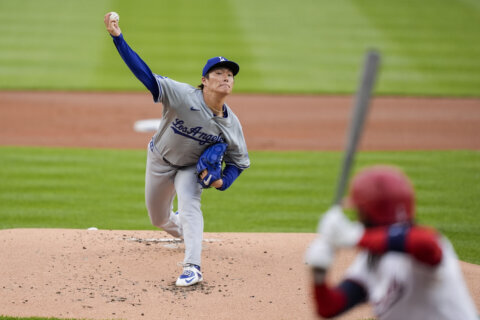WASHINGTON — Both Jon Heyman and Ken Rosenthal reported Thursday afternoon that the Washington Nationals have ramped up interest in free agent outfielder Yoenis Cespedes, the very player that helped carry the New York Mets past Washington to an NL East title after a midsummer trade last year. Heyman first reported the team’s increased interest, while Rosenthal reported the team had offered a five-year deal, according to sources, which would mean a nine-figure offer.
At first blush, the Nats don’t look like a team in the market to add a $100-millon+ outfielder like Cespedes. The team has a highly-paid veteran entrenched in left field, Cespedes’ best defensive position, and just traded for a center fielder and presumed leadoff hitter in Ben Revere. With the National League MVP in right, where exactly is there room for a player like Cespedes in the 2016 lineup?
To answer that requires thinking in larger terms about both the present and future of the club. At 37, Jayson Werth is returning from his worst year as a professional, in which he slashed just .221/.302/.384 in 88 injury-plagued games. Perhaps he will return to the form that saw him finish in the top 20 in NL MVP voting each of the prior two seasons, but with a litany of serious injuries and the inevitable march of time weighing against his chances, it’s fair to question which version of him to expect in 2016.
Werth is also entering the sixth and penultimate year of his mammoth free agent contract. And while he was worth 10.8 bWAR over the first four seasons of that deal (justifying his expense, despite what detractors may believe), he was a liability in the lineup and the field in 2015, netting negative bWAR totals in each category.
Revere, meanwhile, is coming off a career year, in which he performed even better following a trade to Toronto in the season’s second half. As a 30+ steal candidate and career .295 hitter, he looks like the prototypical candidate to replace Denard Span as a leadoff hitter and center fielder. But a more thorough vetting of his numbers reveal weaknesses that should not be ignored.
Despite last year’s success, Revere has never posted even a league average OPS, with a career OPS+ mark of just 88. In spite of his high average, his career on-base percentage is also just .328, far lower than Span’s .352 mark. And though he may look the part of a solid center fielder, both Baseball Reference (-2.5 career dWAR) and FanGraphs (-26 career DRS in CF) rate him as a well below average defender at the position he is most likely to be used.
Cespedes is, admittedly, no great shakes in center, but he ranks about the same as Revere while adding significantly more offense to the lineup. While it may be too much to expect a repeat of 2015, the slugger had averaged 26 home runs and a 122 OPS+ playing in mostly cavernous ballparks in Oakland, Detroit and New York, averaging 4.0 bWAR as a big leaguer. There is also the possibility that Cespedes could shift to right field — where his arm would play up and his limited range would be less exposed — with Bryce Harper shifting back to center, where he played in 2012. Harper’s metrics in center are better than either Cespedes’ or Revere’s, but the club might not want to expose him to the rigors of playing there everyday.
But that’s why Cespedes makes sense. With him on the team, nobody has to play center every day. He affords a flexibility to mix and match lineups and defenses according to matchups and health, one that the Nationals never had last year, when their injuries derailed their season. How the options are juggled will be up to Dusty Baker, but as Joe Maddon’s Rays/Cubs and Bob Melvin’s A’s have shown us over the past few years, the very idea of set, everyday players at each position is a shifting paradigm in the game.
At 30, it’s reasonable to expect that his first three years of a deal would be his most productive, the three in which Harper is still under contract in D.C. And with Werth’s deal expiring after 2017, Cespedes would provide a long-term solution in the corner outfield, where he is excellent, through 2020. In case you’re unfamiliar with his arm, it’s quite strong.
A Cespedes acquisition would appear to position Michael Taylor as the odd man out. Nationals personnel have loved Taylor since way back in his low-A ball days, but he has developed more slowly than expected. Despite a decent defensive showing in 2015, his OPS+ was a grisly 72. Even a 14-homer, 16-steal campaign doesn’t put much polish on a .229/.282/.358 slash line.
Taylor isn’t young anymore, either, turning 25 before Opening Day. The Nats could always keep him as a bench player or shuttle him back to Triple-A in case of emergency, but they might be better off letting another team dream high on his eventual development and try to add another back-end arm to their revamped bullpen in a trade.
Then, there’s the money. Any contract that nets Cespedes would rank as at least the third-biggest free agent signing in the Nationals’ young history, behind only Max Scherzer ($210 million) and probably Werth ($122+ million) in total value. The Lerner family has shown a willingness to spend money in the offseason, with payroll increasing every year since 2007 ($37.4 million), up better than 400 percent from that low-water mark last season ($162 million).
However, they’ve been notoriously reticent to add money once the season has begun. This might be Mike Rizzo’s best opportunity to upgrade the club, as he simply may not have the flexibility that many of his peers do to make wholesale changes in July.
While Cespedes may not appear a perfect fit on the surface, he answers lots of the Nationals’ questions entering 2016 and gives them the flexibility to adjust as the landscape changes in the future.






